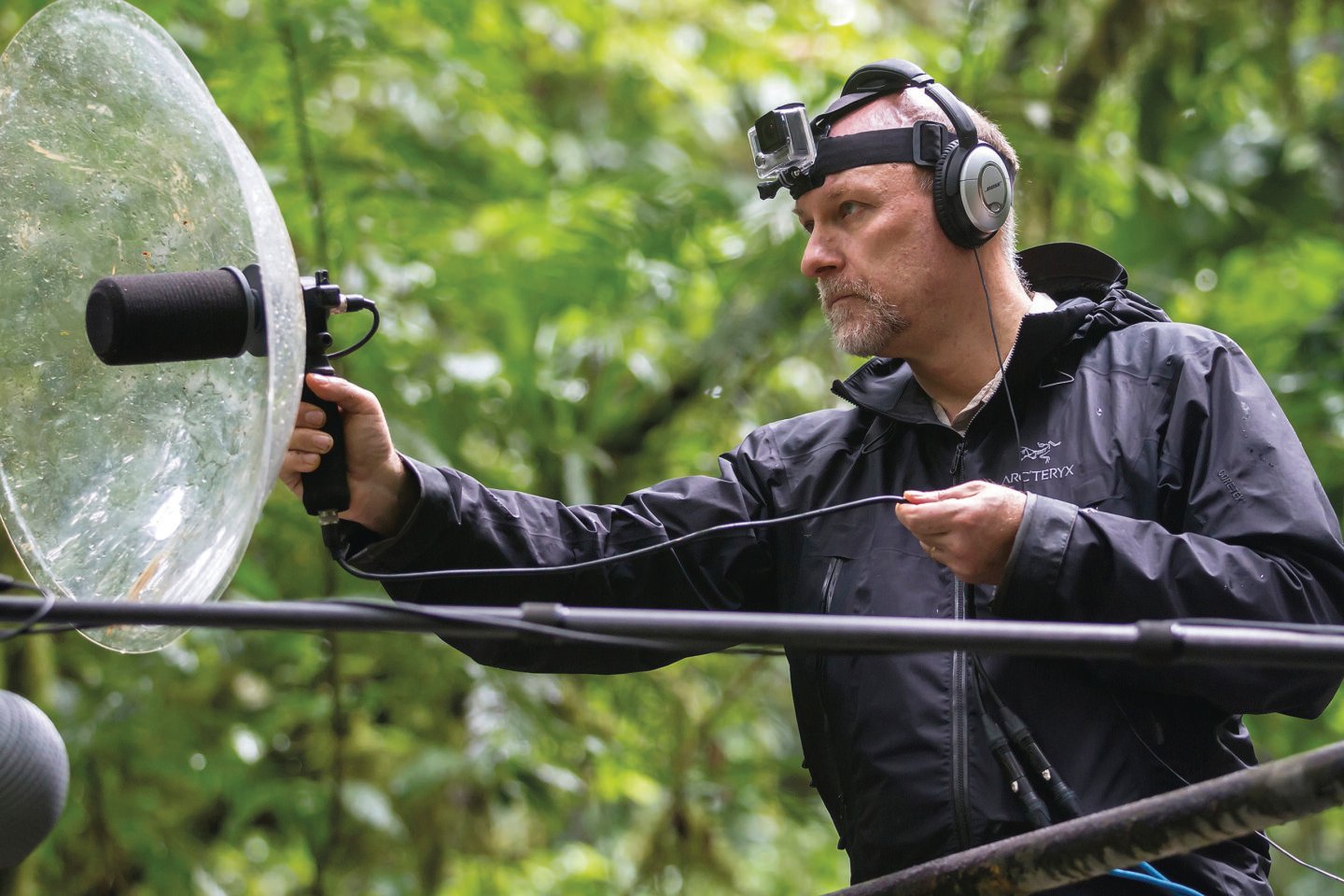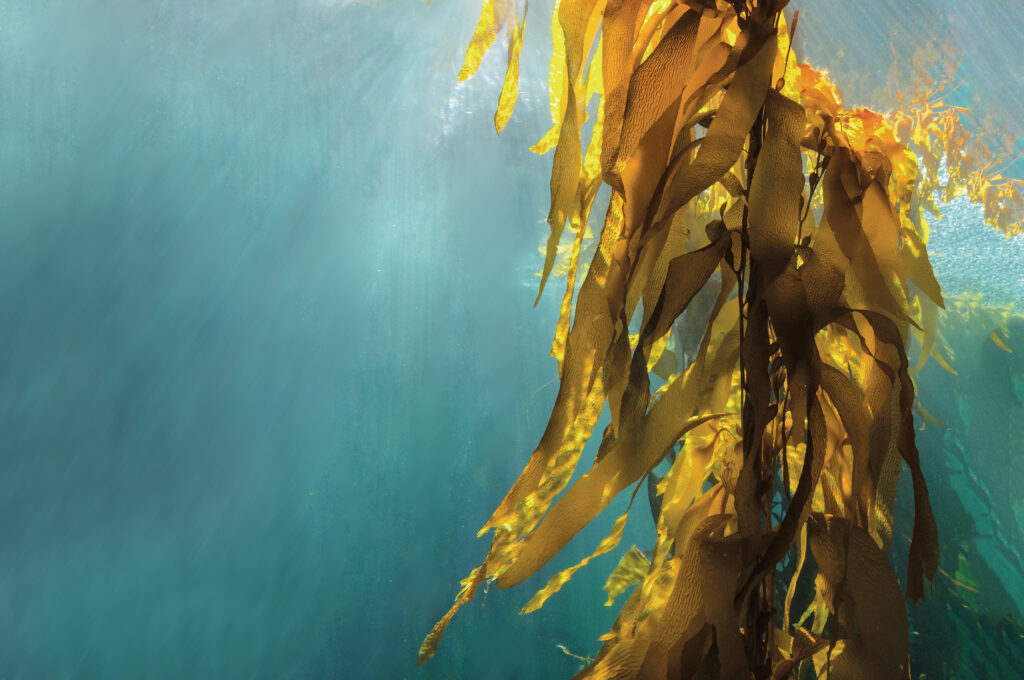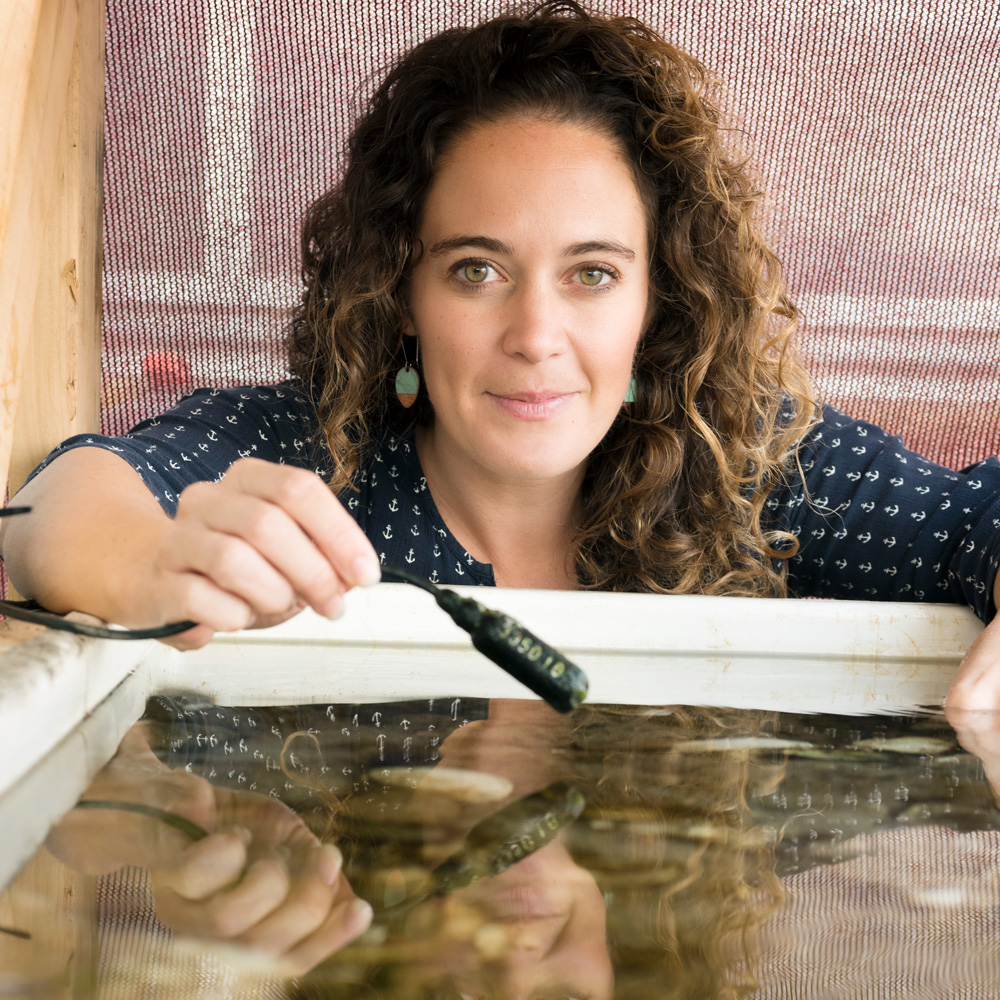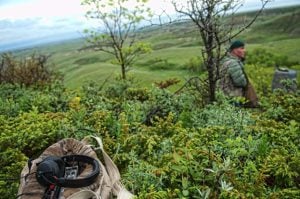
Environment
The sixth extinction
The planet is in the midst of drastic biodiversity loss that some experts think may be the next great species die-off. How did we get here and what can be done about it?
- 4895 words
- 20 minutes
Wildlife
Recording the soundscapes of our ecosystems is a burgeoning field that allows researchers to better decode what the Earth is saying. But are we listening?

Our planet has a soundtrack. There are the birds, of course — the chirps, warbles, tweedles, whistles and clicks of the dawn chorus. But mammals play in Earth’s orchestra, too. Lions roar. Moose bellow. The panther has its deadly purr.
Insects are famously chatty; just ask the cicadas. Crocodiles snap. And where would Earth’s concert be without the languorous basso of the bullfrog? Fish burble. Whales sing in linguistically discrete dialects. Coral reefs are underwater symphonies with shrimp snapping out the beat.
Plants emit sound waves. Pea seedlings listen for the flow of water. Bacteria converse, albeit at ranges higher than we can hear. Even a fungus may be able to talk; scientists say the thready networks of root fungi that link forests may be as gabby as a schoolyard at recess.
It’s not just the living that sing. Winds rustle. Water falls. Thunder booms. Glaciers splinter and the planet’s crust cracks into rifts.
Together, these sounds tell a story that scientists are just learning to decode.
“Sound is a really marvellous thing that’s around us that we’ve just ignored as a global society, but also as a scientific community,” says Bryan Pijanowski, an avian ecologist at Purdue University in Indiana who established the research discipline of soundscape ecology in 2011 along with a few colleagues.
The idea that sound is a clue to the health of our world began to be examined about 60 years ago when the American naturalist Rachel Carson published her book Silent Spring, an elegy to the vast numbers of birds killed by pesticides.
In the decades since, new generations of scientists have begun piecing together just how critical the acoustic assemblage of the planet is for creatures that communicate by sound.

“Sound has become the last frontier,” says Pijanowski, who is director of the Center for Global Soundscapes at Purdue. “We’re such a visual species, and we put such a high priority on it that we’ve discounted sound as a means to assess change and measure change.”
And the truth is, Earth is singing a strange and troubling song. The planet’s biophony — the sounds living creatures make — is being silenced. Humans are cutting down forests, ploughing fields, emptying the seas, killing wildlife, introducing invasive species.

In some places, the original soundscape has vanished, according to Bernie Krause, the California-based musician and naturalist who has amassed the world’s oldest collection of ecosystem sounds. Beginning in the late 1960s in the equatorial forests of Africa, Latin America and Asia, Krause started tenderly recording everything a particular soundscape had to offer, a shift from the usual practice of chasing the voices of individual creatures. He wanted to know what the animals heard in the world around them. Did a specific patch of the planet have a soundscape in a particular key? What happened at night? The result was 4,500 hours of tapes.
“For me, listening with open ears enhanced a sense of extraordinary humility and imparted a sacred gift: a souvenir of living sound from a distinct place at a moment in time,” he wrote in his 2012 book The Great Animal Orchestra.
Today, nearly half of those soundscapes exist only in his library. They are acoustic fossils.
And the depleted soundscapes that remain are competing with human-made noises, known as the anthrophony. Not just our voices — ever more numerous — but our doings, too. Factories, cars, ships, jets, bombs, bulldozers, air conditioners.
More sinister, we’re changing the fundamental media through which sound waves move. The carbon load in the atmosphere is making air hotter and wetter or sometimes hotter and drier, throwing the planet’s instruments out of tune. It is causing the ocean to be warmer and less saline, and so sound waves move more quickly. Cyclones, wildfires, storms and floods are becoming more prevalent, altering the planet’s geological voice.
Earth is talking. Are we listening?
“Oh, absolutely not,” Pijanowski says.

Sound is intimate. Its waves pound against our bodies, penetrate the inner ear, pulse through our skin, flesh and bones. Sound tells us where we are, but it also evokes the memory of where we used to be. It carries with it a sense of time and place. We humans use the sounds we make to delight, woo, warn and even worship.
“When you’re dealing with vision, there are light waves. But sound is something that is actually physical. You’re being hit by it. You can hear it, and you’re feeling it,” says Valeria Vergara, a research scientist who is co-director of the Raincoast Conservation Foundation’s cetacean research program based in British Columbia. She studies the calls that baby belugas and their mothers make, among other acoustic topics.
Vergara remembers sitting in a tent on the edge of the Arctic Ocean where belugas bring their newborn calves for a few weeks each year. It was piercingly cold and so foggy that she couldn’t see anything, but she could hear the occasional beluga blow above the surface of the sea. When she hooked up her underwater microphone, she was all of a sudden plunged into the complex, loquacious world of beluga chatter. “In my core, I felt, wow, this is what it must be like to be an acoustic species where sound is everything,” she says.
Sound is a way to reconnect us [to nature] because it’s an emotional trigger. It’s an emotional bridge to place.
For whales and other marine creatures, sound is far more important than vision. For one thing, water carries sound nearly five times more quickly than air does, making it an efficient medium for sonar communication. As well, part of a marine creature’s life is spent in water too deep for light to reach, further sidelining the use of sight. And in the Arctic and Southern oceans, marine mammals live without any sunlight for half the year, fully dependent on what they can hear.
“They live in a world of sound. Every sound they hear tells them something,” Vergara says. “Every sound they hear tells them where they are located in relation to their peers, tells them how far away from them their little calf might be, tells them where to navigate, where there might be an ice hole or an ice lead where there might be prey.”

Getting a full picture of how most creatures use sound is still elusive. Biologists have found that frogs and toads use their voices to attract mates, for example. Birds sing to sound alarms, defend their territory and let other birds know that they’re there. Bats use echolocation to find prey. Fish use it to migrate and synchronize spawning.
Creatures also seem to communicate across species, using their voices to establish their own niche in a soundscape, like the harmonies in a choir. That means scientists can figure out what Pijanowski calls an ecosystem’s “acoustic heritage” by assessing the range of pitches in an area, understanding how and when creatures showed up in an ecosystem. It’s like hearing evolution.
But there’s no full catalogue yet of what sounds specific creatures make, apart from most birds, Pijanowski notes. When it comes to listening to a whole ecosystem rather than the individuals within it, even the most basic information is often lacking.

That’s why Pijanowski is on a mission to record the most pristine examples of Earth’s roughly 30 unique biomes. So far, he’s got 27, recorded in some of the most remote parts of the planet, like the eastern steppes of Mongolia. Still to come: the spiny forest of Madagascar, the boreal forest and the temperate rainforest. It’s a pioneering baseline of information that he hopes to assess and then compare with research on climate disruption and the loss of species. He’s also keen to understand how humans are reacting to those sonic changes.
“My great worry is that we would potentially become disconnected from nature,” he says. “Sound is a way to reconnect us because it’s an emotional trigger. It’s an emotional bridge to place.”
He’s aware that time is of the essence. He and the oceanographer Craig Brown of Dalhousie University in Halifax made a plea earlier this year to colleagues in the pages of the journal Frontiers of Remote Sensing to get a wiggle on.
The time is ripe. Technologies to collect soundscapes have advanced dramatically in recent years. All of a sudden, a discipline that was clumsy, slow, labour-intensive and fraught with technical failure (think computers hooked to microphones in suitcases) has become as easy as putting up a passive digital recorder or listening to a satellite feed. And advances in artificial intelligence mean that parsing meaning from the recordings is getting easier, too.
“We’ve gone from low-tech to a technology that records 48,000 times a second. So we have one of the most detailed means of collecting data available to us,” Pijanowski says. “And we can probe these files, ask the questions.”
Who or what, exactly, is making the sounds? What happens to a soundscape when one species vanishes? Does another enter in its acoustic space or does that space remain empty? How does that soundscape compare to what was here a year ago? Data mining tools are so powerful now that they can begin to answer some of these questions by seeking patterns in the sounds. For example, Pijanowski is working with NASA using remote sensing from the International Space Station to develop a global model of how climate heating is changing ecosystems, pairing his biome soundscapes with maps of habitats.


It’s not just technological progress that is driving the interest, though. Passion for the field has exploded. Published research papers have gone from just a handful a year in the early 1990s to hundreds today. Researchers span most continents and many countries. “When we first started talking about this, small community that we were, we were struggling just trying to get our main concepts out there,” Pijanowski says. “Now there’s lots of questions, lots of intrigue.”
While the answers to those questions are still in the works, it’s a big leap from 1977, when the Canadian musician R. Murray Schafer popularized the term “soundscape” in his influential work The Tuning of the World, which was as much a dissertation on sound as a lyrical invocation to future scholars and musicians to bear “earwitness” to the planet. “The world is a huge musical composition that’s going on all the time, without a beginning and presumably without an ending,” Schafer once said.
The Global Library of Underwater Biological Sounds, a.k.a. GLUBS, is making the case for listening, too. A collaboration among 17 scientists in nine countries, GLUBS announced earlier this year its goal of gathering vast collections of marine sounds onto a single global web-based platform. The impetus? The mounting realization that humans have not just warmed the planet and altered its landscapes, not just pushed a million species to the brink of extinction, not just fiddled with the patterns of rainfall and wind and seasons, but that we’ve also meddled with the ancient, secret way wildlife communicate in order to survive.
“It’s not necessarily loss,” Pijanowski says, referring to the emotion he feels as he races to capture the voice of the planet. “It’s concern about what we’re doing in ways we don’t fully understand or don’t even think about.”

During the first week of life, a baby beluga struggles to make what biologists refer to as its “contact call.” Belugas, the famously goofy-looking white whales, produce hundreds of different calls, but the contact call carries high importance. It’s used to maintain cohesion among the pod and keep mother and baby in touch. In those first few days, though, the baby’s voice is weak, and the contact call is undeveloped. It sounds like somebody running a finger across the teeth of a comb, Vergara says.

She and some colleagues started to wonder how the swell of human-made noises in the ocean would affect the mother’s ability to hear her newborn. They were particularly worried about the endangered, isolated population of 900 belugas in the highly industrialized St. Lawrence Estuary. An unusually high number of baby belugas have died there since 2008.
Their research, published last year in the journal Polar Research, showed that when ship noise was present, the contact calls of those days-old belugas had only half the reach as when the estuary was quiet. Put that finding together with the risks to the St. Lawrence belugas from toxic spills, harmful algal blooms, rope entanglements and poor food supply, and it’s a sombre picture. “If there’s any disturbance that causes mom and calf to separate, then the ability of them to reunite is compromised because the mom might not hear the calf,” Vergara says.
It’s not just the St. Lawrence belugas that are affected by human noise. In the Beaufort Sea, migrating belugas and bowhead whales flee from the sounds of helicopters and fixed-wing planes, diving, turning around or breaching the surface to get away.
Other types of whales, especially the beaked varieties, are affected by navy sonar. They go deep, stop their own vocalizations and cease foraging for food when they hear the noise. Whale strandings have also been linked to naval sonar waves, possibly because the mammals surface too swiftly from the depths and die from a whale version of the bends. Bottlenose dolphins in the western North Atlantic dumb down their whistles when vessel traffic is heavy, impairing their ability to communicate with each other.
The embryos of sea hares, the voracious marine mollusks that keep poisonous algae under control, are far more apt to die when noisy boats are near. Boat noise and other human-made sounds can also mask the acoustic information fish need to acquire from their surroundings.

“The soundscape in the ocean is being injected by the human component to a much larger degree than in decades past,” Vergara says. “And there are very few places on Earth today where a whale can get respite from human noise. There is the constant, constant low-frequency hum of faraway cargo ships. There is the coming and going of ecotourism boats, jet skis, private boats, big vessels. It’s a noisy world out there.”
An experiment during one tiny window of reduced noise highlights her point. After the events of September 11, 2001, acoustic pollution in the Bay of Fundy fell by six decibels because ship traffic declined. As noise receded, North Atlantic right whales, now critically endangered, became significantly calmer, a fact scientists discovered by measuring stress hormones in the feces of a small group they were tracking.
And then there’s carbon.
While the impact of human-made sounds is an obvious subject for scientific scrutiny, investigations are also underway into the subtler changes that climate heating is having on the planet’s music. “People have been really worried and pushing about anthropogenic noise and how that’s affecting and changing the soundscape. But I’m thinking, ‘What about just changes to the types of biological sounds that are already there?’” says Ashlee Lillis, a Canadian marine ecologist who founded the independent research organization Sound Ocean Science.
Consider snapping shrimp. Scientists rarely catch sight of any of the 600 or so tropical species that live inside coral reefs, but they hear them. The shrimp make some of the most pervasive sounds in the ocean. Lillis has discovered that the shrimps’ voices are changing as the carbon load in the atmosphere heats up the ocean. Not only are the shrimp spreading to more parts of the ocean, but they’re also making more noise, snapping more frequently as the water warms. That’s a fundamental change to parts of the ocean’s soundscape. “If you’re a little oyster larva, you might think this is great,” she says, a nod to her finding that larvae can be attracted by the sounds of other species to settle on a reef. “But if you’re a fish that needs to talk to the other fish, or use acoustic communication for mating or whatever, then it might actually be a big bummer to suddenly have a lot of shrimp making noise and masking [other sounds].”

On land, climate heating is changing the rhythm of the soundscape, Pijanowski says. Insects and amphibians are the tappers and clickers that keep the beat in a healthy ecosystem. Over the seasons, they develop according to heat in the air or soil. As the spring and winter become warmer, these tempo organisms become active and breed earlier. But the life cycles of birds and mammals are driven by the amount of light, not by temperature. And light is not changing. It’s like different parts of an orchestra playing the same score at different times.
Not only that, but temperature has a direct effect on the activity of neurons and muscles that control sound in all sorts of land and water creatures, explain Krause and his co-authors in a recent paper in Trends in Ecology & Evolution. That can affect a voice’s pitch, volume and repetition rate. Those are changing as the planet warms.
As well, unusual weather conditions, such as bursts of extreme rain or heat, wildfires, droughts, floods and cyclones — which are all on the rise — can also disturb Earth’s symphony. That could take the form of changing the physical movement of sound waves in different temperatures and humidities, but also of drowning out the vocalizations of species that are trying to connect with each other. “The loss and gain of soniferous species could thus strongly rearrange the natural soundscapes of large areas,” Krause and his co-authors write.

In the Amazon, for example, the soundtrack of forests that experienced recurrent fires was starkly quieter, with a smaller range of voices, than forests that had been burned just once or logged and then left to recover, according to a study published this year in Proceedings of the National Academy of Sciences.
Many of these changes to the planet’s acoustic fingerprint will be amplified as the carbon load in the atmosphere increases. Ocean acidification, caused by atmospheric carbon dioxide dissolving into the water, is set to impair the ability of some marine creatures not to make sounds but to make use of them.
Experiments conducted in Ruakaka, New Zealand, with wild-caught snapper showed that the fish’s otoliths, their tiny ear bones, became both bigger and lopsided in more acidic water, according to a study published last year in Proceedings of the Royal Society B: Biological Sciences. That meant the snappers couldn’t hear low frequencies, the main type of sound wave they rely on. The more acidic water also seemed to disrupt brain function, making it difficult for fish to make decisions. It’s a poor recipe for survival in the more acidic ocean of the future.
Unless global heating is reined in, the ocean of the coming decades will also be home to more types of acoustic disruption, says Alice Affatati, an engineer and independent bioacoustics researcher who, with a grant from Memorial University in Newfoundland, looked at how sound speeds will change in warmer water. Her study, a global first that was published last year, found that sound will speed up and last longer, particularly in several parts of the ocean she and her co-authors call “acoustic hotspots.” “We were kind of surprised by the big change we found,” Affatati says.
One of those hotspots will be in the biologically diverse area off the coast of Newfoundland, where the Labrador Current hits the Gulf Stream. That’s because the speed of sound in the water is governed by the water’s temperature and salinity and, under future climate scenarios, these will combine in that spot to make sound travel faster. How much faster? Enough to eradicate the variations in sound speed that happen now as those parts of the ocean cycle through winter to summer, explains Stefano Salon, a physicist at the Instituto Nazionale di Oceanografia e di Geofisica Sperimentale in Trieste, Italy, who was a co-author on the paper. “It means that we are going to practically destroy the seasons,” he says. He wonders whether marine life will have time to adapt.

A countermelody runs through this scramble to decipher Earth’s musical code. It is a refrain of hope.
Rather than simply capturing soundscapes or trying to assess how they are changing, some scientists have begun harnessing what the planet is saying in order to protect it. A group led by Sarab Sethi of Cambridge University is developing solar-powered autonomous monitoring units that can tell in real time whether illegal logging or hunting is taking place in a protected area. The monitoring systems, tested in Malaysia and the United States but adaptable to many landscapes, can identify the whine of chainsaws, the chop of an axe or the crack of a gun.
Some ecologists have developed indexes of acoustic information for flash assessments of how well protected spaces on land and in the water are being managed. One is an index to assess diversity, for example. But fundamental questions remain. Pijanowski has put out a call in Frontiers in Remote Sensing for research articles exploring just how useful they are and whether other indexes ought to be developed.
Creatures also seem to communicate across species, using their voices to establish their own niche in a soundscape, like the harmonies in a choir.
For Simon Butler, a conservation ecologist at the University of East Anglia in the U.K., the task is resurrecting lost soundscapes. In a recent study, he used yearly bird counts by citizen scientists to reconstruct what more than 200,000 spots in North America and Europe sounded like a quarter of a century ago when birds were much more plentiful. In a Nature podcast about his work, he mused that it might also be possible to figure out how these spots will sound in the future as species are forced to move because of climate heating. Alerting people to those future losses might be another way to connect us to the importance of nature — and of preserving it.
Work done by Lillis off the coast of North Carolina and by ecologists in Australia goes even further. They have shown that playing healthy soundscapes in degraded marine ecosystems can help restore them. The phantom sounds of lost habitats, piped from speakers onto the seabed, are cues for oyster larvae, encouraging them to fasten to the abandoned shells of adult oysters and rebuild.
It’s not the final answer, Lillis is quick to point out. There’s no sense attracting reef-building larvae to part of the ocean that’s so degraded the oysters won’t be able to survive. A parallel effort has to be to address the big environmental issues the world faces.
But all the same, any tiny step feels like an act of reparation.
Are you passionate about Canadian geography?
You can support Canadian Geographic in 3 ways:

This story is from the September/October 2022 Issue

Environment
The planet is in the midst of drastic biodiversity loss that some experts think may be the next great species die-off. How did we get here and what can be done about it?

Environment
David Boyd, a Canadian environmental lawyer and UN Special Rapporteur on Human Rights and the Environment, reveals how recognizing the human right to a healthy environment can spur positive action for the planet

Science & Tech
A sound artist listens for quiet in Grasslands National Park

People & Culture
The family physician advocates for outdoor time with the PaRx nature prescription program